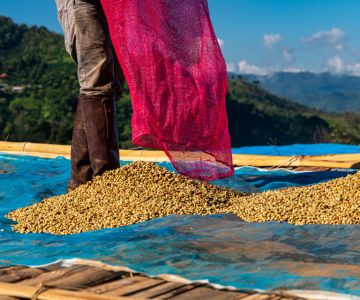<Coffee for the Average Josh, Part 5 of 10>
Comedian Brian Regan feels insulted that Pop-Tarts come with printed preparation instructions.
“Can there be a simpler food item?” he says. “Like if the directions weren’t there, would someone be like, ‘How do I get that goodness in me?’”
Not so with coffee. There seem to be as many ways of consuming coffee as there are drinkers.
How do you take your coffee? Here are 10 ways coffee drinkers “get that goodness in me.” How many have you tried?
1. Cream and sugar
Classic. Every diner table worth its salt is stocked with these two options.
While seemingly straightforward, the options are endless. There are a million sugar alternatives — from Splenda to In the Raw —or sweeten the cup with a touch of honey.
Cream starts with dairy options like heavy whipping cream, half and half, and milk. Then there’s the litany of non-dairy commercial creamers with names like “Toasted Marshmallow Mocha” — which, incidentally rarely list marshmallows and chocolate as actual ingredients and is never actually toasted.
2. Decaffeinated
Love coffee but want to sleep soon? Decaf was made for you — though it wasn’t grown for you. Coffee beans are harvested with caffeine (you can’t order a decaf Arabica plant), and so the beans need to go through a process of decaffeination after leaving the farm but before they are roasted.
There are two common ways this is done: one you want to know about, and one you don’t.
The one you want to know has a beautiful name: the Swiss Water Process. Beans are soaked in water, and then a science glossary walks up and smacks the caffeine out of them using solubility, osmosis and a carbon filter.
The other way to decaffeinate is with a paint stripper. OK, OK, so it starts with a water soak but then a solvent thug is brought in to actually — avert your eyes, kids — bada-bing the caffeine right out of Mr. Bean. The most commonly used solvents are methylene chloride (used to strip paint) and ethyl acetate (used in nail polish remover).
But don’t worry, the FDA has signed off on the whole thing so long as the solvents that remain stay below certain thresholds, so … nighty-night.
3. Instant
The Pop-Tart of coffee in that it’s ready in a jiffy, the instant variety comes in a powder form — just add hot water!
This is not to be confused with ground coffee, which is just a pulverized coffee bean. Instant coffee, on the other hand, was actually once a brewed cup of coffee that — thanks to the magic of manufacturing and/or elves — transformed back into a solid granule state.
4. Iced
Iced coffee is simply coffee that was brewed hot and then cooled down by refrigeration or ice.
5. Cold brew
Unlike iced coffee, cold brew was always cold. For this method, coffee grounds are steeped in cold water, with recipes generally ranging from 12 to 24 hours. When you’re ready to drink, simply strain out the grounds. Cold brew fans tend to rave about its smooth taste and low acidity.
6. Frozen coffee
Frozen: It’s where coffee goes “Into the Unknown.” (Amirite, Elsa?)
With names like Vanilla Bean Frappuccino, McCafe Mocha Frappe, Frozen Dunkaccino, Cocomo Dutch Freeze, Caribou Cooler, Chick-fil-A Frosted Coffee, what we are essentially talking about here is a million different ways to make a coffee slushie.
Most use powder mixes because many customers prefer the consistency, though some may blend ice and espresso shots. Usually, they taste like dessert and can be indistinguishable from a chocolate milkshake. (If what you want is to blend in a hot espresso shot, it helps to specify that. Some people who want a little more of that coffee punch will even add a hot espresso shot to an instant coffee mix recipe.)
It’s worth the experimentation at your favorite shop. When you score a blended ice coffee drink that perfectly suits your palate, it’s a glorious thing.
In my experience, frozen coffee drinks are the hardest to order using a common vocabulary. For instance …
Frappe: As it refers to drinks, this word has French and Greek heritage. It typically refers to a recipe that is a combination of milk, sugar, ice and instant coffee mix.
Granita: Originating from Italy, this word describes a frozen treat that is served somewhere on the scale of shaved ice to Slurpee. Like those treats, granitas can be flavored with fruit syrups or other sweet accompaniments. Coffee is just one possible flavor for a granita.
But who cares, really? These are just two of many words in Coffee Land that are sometimes used interchangeably, sometimes used for clever marketing, rarely used correctly.
My advice: Enjoy another sip, Olaf, and “Let it Go.”
7. Affogato
In its purest (aka non-alcoholic) form, this dessert is usually represented by the following ratio: one scoop vanilla ice cream (or gelato, if you’re in Affogato’s original Italy), one hot shot of espresso poured on top.
8. White coffee
Not to be confused by coffee recipes that feature milk, such as the flat white, white coffee actually represents an extremely light roast of coffee. White coffee is said to originate in Yemen, and the taste of the roast is notably different than more traditionally roasted coffee. While the flavor can vary, it is typically marked by a nutty quality.
9. Dirty chai
Love tea and coffee? While a chai latte is a common coffee shop drink without the coffee (black tea and spices with steamed milk), it’s not uncommon for people to order drinks like this “dirty”? Don’t get the wrong idea. It just means adding coffee. Coffee-tea marriages are actually common worldwide, particularly in Asia.
10. Irish
If coffee and tea aren’t your thing, how about coffee and Irish whiskey? Irish coffee is just one of many recipes for making coffee that can be measured by “proof.”
What about common espresso drinks and at-home coffee?
In the second half of the Coffee for the Average Josh series, we will spend more time breaking down coffee at the shop (typically espresso) and coffee brewed in the home.
Next: What is espresso?
This is the fifth in a 10-part series, “Coffee for the Average Josh,” releasing Fridays this fall. Get your fix of Coffee 101 by signing up to receive an email when the next post drops.
Previous:
- Where do coffee babies come from? (Oct. 2, 2020)
- Growing up on the coffee farm (Oct. 9, 2020)
- 3 reasons to pay more for your coffee (Oct. 16, 2020)
- 5 factors of great-tasting coffee (Oct. 23, 2020)


